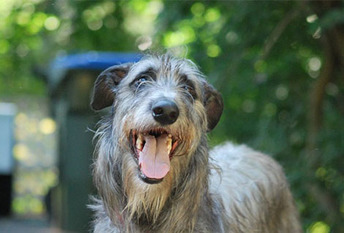The Wolfhound has a rough coat that is especially wiry and long over the eyes and beneath the jaw. Extensive grooming is done to give the dog a perfect appearance in the show ring, but for a pet owner, the coat is easy to maintain. There's just a lot of dogs to groom.
Brush or comb the shaggy, wiry coat once or twice a week to remove dead hair and prevent or remove any mats or tangles. The double coat sheds moderate amounts year-round but doesn’t go through a heavy annual or biannual shed. A bath is rarely necessary.
The rest is basic care. Trim the nails as needed, usually every week or two. Brush the teeth frequently with a vet-approved pet toothpaste for good overall health and fresh breath.
This is one large dog and it needs a large area to play and exercise in. You’ll need to take your Irish Wolfhound out for a walk or run at least twice a day.
You can incorporate your dog’s exercise routine into your workout routine if you like to ride a bike, run or rollerblade. This is where leash training comes in handy, so be sure to start this training from the time your dog is a puppy.
You should feed your Irish Wolfhound a quality diet that features the proper balance of protein, carbs, fats, fiber, vitamins and minerals. Choose a high-quality commercial dog food, a natural brand that comes with human grade food and no fillers or meat by-products.
A high-qualitydog foodappropriate for the dog’s age (puppy, adult, or senior) and ideally formulated for large breeds should have all the nutrients the Irish Wolfhound needs. Because of the risk ofbloat, strenuous exercise is not recommended before or after feeding time.
Check with the dog’s breeder and your vet if you have any questions or concerns about your dog’s weight, diet, or feeding schedule.
Just like all dog breeds, the Irish Wolfhound can suffer from health problems. Some health issues that are common to this breed are bone cancer, cardiomyopathy, hip dysplasia (a type of arthritis that affects large dogs which is painful and decreases the ability to walk or run), Von Willebrands, PRA and bloat (caused by feeding your dog too much food at one time) and could require surgery.
To keep your Irish Wolfhound healthy, make sure to take your dog out for regular exercise and visit the veterinarian when needed.
Training an Irish Wolfhound is quite easy, since this breed is intelligent and loves to please. Start training as early as possible, as you will find a puppy easier to handle.
Start your training with leash control. The Irish Wolfhound likes to pull on the leash, so you need to teach your dog that this behavior is unacceptable. Leash training is especially important because as your dog grows bigger, it will have no problems dragging you along on its leash.
The best way to train an Irish Wolfhound is to be consistent and patient. When your dog follows a command, reward it with a treat, and when it does something wrong, firmly but positively correct the behavior.
Because the Irish Wolfhound is smart, it will quickly understand what is expected. You should continue to work with your dog, even when it starts to mature. As well, be sure to socialize your Irish Wolfhound with other dogs and people so that it does not become frightened.











